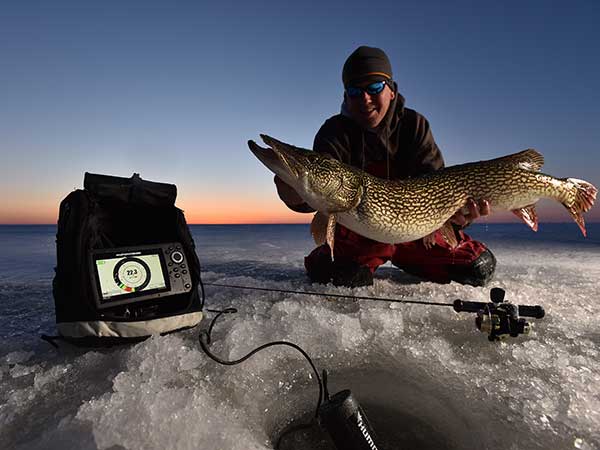By Louie Stout
 Ice fishing has gone high-tech.
Ice fishing has gone high-tech.
Photo courtesy of Bill Lindner/Humminbird
If its been awhile since youve looked at ice fishing tackle in a sporting goods retail store, brace yourself for sticker shock.
You can still find a few of those cheap ice rods that include line, bobber and jig. You know the kind that the line wrapped around a wire handle.
You also can walk out of a store with an inexpensive ice rod and reel, a handful of jigs and tub of bait that will get you on the ice for around $20.
But todays ice gear manufacturers offer some high tech options and anglers are taking advantage of it. Those who use the more sophisticated equipment swear they are far more efficient at finding fish and getting them to bite.
Reels: For example, an ultralight spinning reel considered high tech in my day has become ho-hum among ice aficionados who see the inline style of reel as a new and better option.
Seems like when someone uses one, its the only one he wants for ice fishing, said Darrin Schaap, whose Clear H2o Tackle in Edwardsburg serves as this areas ice fishing specialty shop.
The in-line reel resembles a fly fishermans reel. It nearly eliminates line snarl issues that are common with the dainty (2 pound) line that many anglers now use. Anyone who has battled tangled, twisted lines with frozen fingers while using a spinning reel knows how frustrating that can be.
The reels not only diminish any line twist but they improve the life span of the line because its not getting abused from twisting, Schaap added. Many have long stems between the rod and the reel to accommodate bulky gloved fingers.
Costs? Well, you can get into a basic model for about $30 or go deluxe and spend upwards of a $100 for more bells and whistles.
Line: Anglers have become equally discriminating about the line they use. Monofilament still sells, but specialty lines formulated specifically for ice tactics have become more popular. Many anglers are employing more expensive fluorocarbon or braided lines with small diameters into their fishing and paying twice as much or more as they do for monofilament.
Rods: Ice rods have come a long way, too. While value priced rods are made of fiberglass, serious ice anglers are gravitating toward graphite or composite blends. There are ice rods made of the same materials as a $250 graphite bass rod and priced up to $80 or more. Of course, you can still find some good ice rods in the $20-$30 range.
The premium rods are lighter than a feather and scary sensitive, Schaap said. They come in all sizes and actions and some come with a built in spring bobber.
Bobbers: The cheap cork or sponge bobber that works fine for when fish are aggressive, no longer is acceptable for ice fishing purists. Premium spring bobber rigs will detect bites that go unnoticed on a traditional bobber rig.
Its the hottest trend because the springs are positioned perfectly on the rod and are marketed for different lure weights and sensitivities, said Schaap. For example, one may be built for tiny jigs or flies while another is built for heavier jigging baits.
Jigs: Traditional lead-head teardrop jigs are still available, but tiny jigs made of tungsten are more popular due to their proportionately smaller size and appearance. A tungsten jig will be two-thirds the size of a lead jig of the same size.
Most are designed to sit horizontally in the water for better action and the color schemes are very detailed, said Schaap. Even the ice flies have been dressed up with tungsten beads to add weight.
Electronics: Modern-day electronics are a must. Newer versions will show fish that are directly beneath your ice hole and you can see your tiny bait on the screen. You can literally watch the fish rise to take your bait.
Some of the more sophisticated fishfinders come with GPS capability to guide you directly to specific weed beds and the precise spot where you caught them last year. Or, you can get one that has a built in underwater camera that allows you to see your bait and the fish that approach it. Those electronics will cost you from $300 for a basic unit to as much as $2,000 for one with a larger screen and underwater viewing system.
Shanties: Lightweight portable ice shanties will keep you protected from the elements, but pricier ones have thermal fabrics that insulate the unit and prevent frost from building up inside. They can be customized, too, with the addition of batteries, portable lights, and consoles for storing bait and gear. The bare bones shanty that breaks down into a sled can be had for around $200 or you can go deluxe and spend up to $700 for a cozy two-man condo.
Augers: Auger technology has improved too, as newer models operate on one-pound propane tanks that are more efficient than gas-operated augers.
If you want the poor-mans power auger, adapters can be purchased for around $30 that converts a hand-turned auger and a gutsy cordless drill into a power auger.
So is all this necessary to catch panfish through the ice? Of course not. Just ask the ol guy surrounded by flopping bluegill while he sits in the open on a bucket and holds a cheap fiberglass rod.
But if you want to fish in comfort on a frigid day and increase your chances of catching finicky fish, you can find some pretty cool stuff to make you a better angler.





